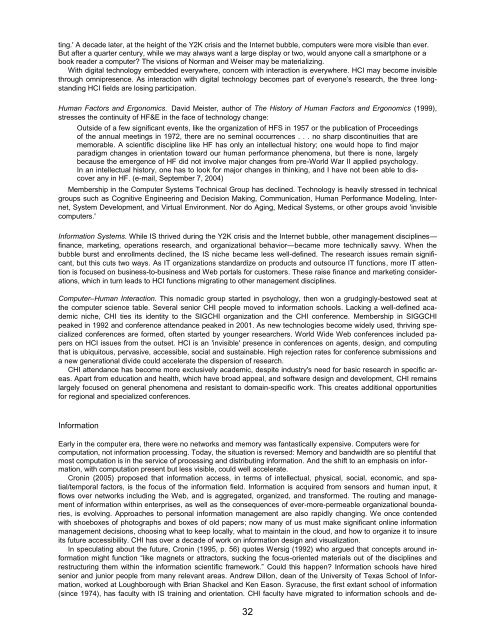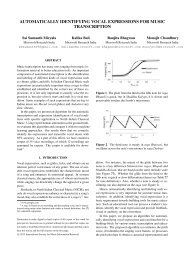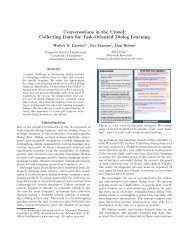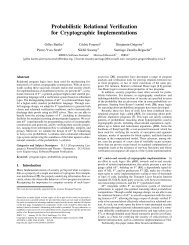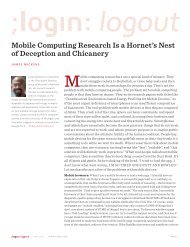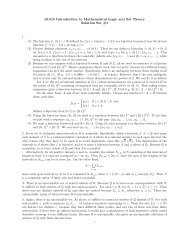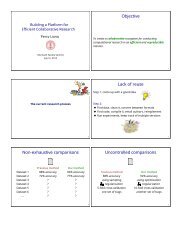A Moving Target—The Evolution of Human-Computer Interaction
A Moving Target—The Evolution of Human-Computer Interaction
A Moving Target—The Evolution of Human-Computer Interaction
Create successful ePaper yourself
Turn your PDF publications into a flip-book with our unique Google optimized e-Paper software.
ting.' A decade later, at the height <strong>of</strong> the Y2K crisis and the Internet bubble, computers were more visible than ever.<br />
But after a quarter century, while we may always want a large display or two, would anyone call a smartphone or a<br />
book reader a computer? The visions <strong>of</strong> Norman and Weiser may be materializing.<br />
With digital technology embedded everywhere, concern with interaction is everywhere. HCI may become invisible<br />
through omnipresence. As interaction with digital technology becomes part <strong>of</strong> everyone’s research, the three longstanding<br />
HCI fields are losing participation.<br />
<strong>Human</strong> Factors and Ergonomics. David Meister, author <strong>of</strong> The History <strong>of</strong> <strong>Human</strong> Factors and Ergonomics (1999),<br />
stresses the continuity <strong>of</strong> HF&E in the face <strong>of</strong> technology change:<br />
Outside <strong>of</strong> a few significant events, like the organization <strong>of</strong> HFS in 1957 or the publication <strong>of</strong> Proceedings<br />
<strong>of</strong> the annual meetings in 1972, there are no seminal occurrences . . . no sharp discontinuities that are<br />
memorable. A scientific discipline like HF has only an intellectual history; one would hope to find major<br />
paradigm changes in orientation toward our human performance phenomena, but there is none, largely<br />
because the emergence <strong>of</strong> HF did not involve major changes from pre-World War II applied psychology.<br />
In an intellectual history, one has to look for major changes in thinking, and I have not been able to discover<br />
any in HF. (e-mail, September 7, 2004)<br />
Membership in the <strong>Computer</strong> Systems Technical Group has declined. Technology is heavily stressed in technical<br />
groups such as Cognitive Engineering and Decision Making, Communication, <strong>Human</strong> Performance Modeling, Internet,<br />
System Development, and Virtual Environment. Nor do Aging, Medical Systems, or other groups avoid 'invisible<br />
computers.'<br />
Information Systems. While IS thrived during the Y2K crisis and the Internet bubble, other management disciplines—<br />
finance, marketing, operations research, and organizational behavior—became more technically savvy. When the<br />
bubble burst and enrollments declined, the IS niche became less well-defined. The research issues remain significant,<br />
but this cuts two ways. As IT organizations standardize on products and outsource IT functions, more IT attention<br />
is focused on business-to-business and Web portals for customers. These raise finance and marketing considerations,<br />
which in turn leads to HCI functions migrating to other management disciplines.<br />
<strong>Computer</strong>–<strong>Human</strong> <strong>Interaction</strong>. This nomadic group started in psychology, then won a grudgingly-bestowed seat at<br />
the computer science table. Several senior CHI people moved to information schools. Lacking a well-defined academic<br />
niche, CHI ties its identity to the SIGCHI organization and the CHI conference. Membership in SIGGCHI<br />
peaked in 1992 and conference attendance peaked in 2001. As new technologies become widely used, thriving specialized<br />
conferences are formed, <strong>of</strong>ten started by younger researchers. World Wide Web conferences included papers<br />
on HCI issues from the outset. HCI is an 'invisible' presence in conferences on agents, design, and computing<br />
that is ubiquitous, pervasive, accessible, social and sustainable. High rejection rates for conference submissions and<br />
a new generational divide could accelerate the dispersion <strong>of</strong> research.<br />
CHI attendance has become more exclusively academic, despite industry's need for basic research in specific areas.<br />
Apart from education and health, which have broad appeal, and s<strong>of</strong>tware design and development, CHI remains<br />
largely focused on general phenomena and resistant to domain-specific work. This creates additional opportunities<br />
for regional and specialized conferences.<br />
Information<br />
Early in the computer era, there were no networks and memory was fantastically expensive. <strong>Computer</strong>s were for<br />
computation, not information processing. Today, the situation is reversed: Memory and bandwidth are so plentiful that<br />
most computation is in the service <strong>of</strong> processing and distributing information. And the shift to an emphasis on information,<br />
with computation present but less visible, could well accelerate.<br />
Cronin (2005) proposed that information access, in terms <strong>of</strong> intellectual, physical, social, economic, and spatial/temporal<br />
factors, is the focus <strong>of</strong> the information field. Information is acquired from sensors and human input, it<br />
flows over networks including the Web, and is aggregated, organized, and transformed. The routing and management<br />
<strong>of</strong> information within enterprises, as well as the consequences <strong>of</strong> ever-more-permeable organizational boundaries,<br />
is evolving. Approaches to personal information management are also rapidly changing. We once contended<br />
with shoeboxes <strong>of</strong> photographs and boxes <strong>of</strong> old papers; now many <strong>of</strong> us must make significant online information<br />
management decisions, choosing what to keep locally, what to maintain in the cloud, and how to organize it to insure<br />
its future accessibility. CHI has over a decade <strong>of</strong> work on information design and visualization.<br />
In speculating about the future, Cronin (1995, p. 56) quotes Wersig (1992) who argued that concepts around information<br />
might function “like magnets or attractors, sucking the focus-oriented materials out <strong>of</strong> the disciplines and<br />
restructuring them within the information scientific framework.” Could this happen? Information schools have hired<br />
senior and junior people from many relevant areas. Andrew Dillon, dean <strong>of</strong> the University <strong>of</strong> Texas School <strong>of</strong> Information,<br />
worked at Loughborough with Brian Shackel and Ken Eason. Syracuse, the first extant school <strong>of</strong> information<br />
(since 1974), has faculty with IS training and orientation. CHI faculty have migrated to information schools and de-<br />
32


